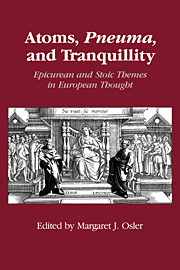Book contents
- Frontmatter
- Contents
- List of contributors
- Acknowledgments
- Introduction
- 1 Ethics and logic in Stoicism
- 2 Medieval connectives, Hellenistic connections: the strange case of propositional logic
- 3 Stoic psychotherapy in the Middle Ages and Renaissance: Petrarch's De remediis
- 4 Alonso de Cartagena and John Calvin as interpreters of Seneca's De clementia
- 5 The Epicurean in Lorenzo Valla's On Pleasure
- 6 Seneca's role in popularizing Epicurus in the sixteenth century
- 7 Stoic contributions to early modern science
- 8 Fortune, fate, and divination: Gassendi's voluntarist theology and the baptism of Epicureanism
- 9 Epicureanism and the creation of a privatist ethic in early seventeenth-century France
- 10 Robert Boyle on Epicurean atheism and atomism
- 11 Stoic and Epicurean doctrines in Newton's system of the world
- 12 Locke, Willis, and the seventeenth-century Epicurean soul
- 13 The Epicurean new way of ideas: Gassendi, Locke, and Berkeley
- 14 The Stoic legacy in the early Scottish Enlightenment
- Index
14 - The Stoic legacy in the early Scottish Enlightenment
Published online by Cambridge University Press: 13 November 2009
- Frontmatter
- Contents
- List of contributors
- Acknowledgments
- Introduction
- 1 Ethics and logic in Stoicism
- 2 Medieval connectives, Hellenistic connections: the strange case of propositional logic
- 3 Stoic psychotherapy in the Middle Ages and Renaissance: Petrarch's De remediis
- 4 Alonso de Cartagena and John Calvin as interpreters of Seneca's De clementia
- 5 The Epicurean in Lorenzo Valla's On Pleasure
- 6 Seneca's role in popularizing Epicurus in the sixteenth century
- 7 Stoic contributions to early modern science
- 8 Fortune, fate, and divination: Gassendi's voluntarist theology and the baptism of Epicureanism
- 9 Epicureanism and the creation of a privatist ethic in early seventeenth-century France
- 10 Robert Boyle on Epicurean atheism and atomism
- 11 Stoic and Epicurean doctrines in Newton's system of the world
- 12 Locke, Willis, and the seventeenth-century Epicurean soul
- 13 The Epicurean new way of ideas: Gassendi, Locke, and Berkeley
- 14 The Stoic legacy in the early Scottish Enlightenment
- Index
Summary
In Scottish thought in the eighteenth century we find something of a reenactment of the ancient debates between Stoics and Skeptics. The Stoic tradition is strongest among the teachers and preachers who find their way into the universities from about 1720 and who close ranks against the skeptical influence of David Hume from the 1740s onwards. Neither tradition survives in a pure classical form, and it would be misleading to suggest that these labels capture all that was at issue; but the adoption of classical models was not inadvertent, and both sides make use, where it suits them, of the language and sources of antiquity. When James Balfour of Pilrig in 1753 sided with the prevailing moralism against Hume's philosophy, Hume offered unsuccessfully to recreate the conditions of social intercourse “when Atticus and Cassius the Epicureans, Cicero the Academic, and Brutus the Stoic, could, all of them, live in unreserved friendship together, and were insensible to all those distinctions, except so far as they furnished agreeable matter to discourse and conversation.” But he was not always so conciliatory. In the first part of this essay I discuss Hume's explicit and generally hostile references to Stoic thought and practice. In the second part I describe the more sympathetic reception accorded to Stoic ideas by some of his Scots contemporaries, who represent a Christian Stoicism which has lost much of its Roman rigor. Hume's own picture of Stoicism is neither Christian nor Roman, but this may be in part a deliberate literary tactic to present a less than flattering portrait of a tradition which, from experience, he did not consider wholly benign.
- Type
- Chapter
- Information
- Atoms, Pneuma, and TranquillityEpicurean and Stoic Themes in European Thought, pp. 273 - 296Publisher: Cambridge University PressPrint publication year: 1991
- 10
- Cited by



